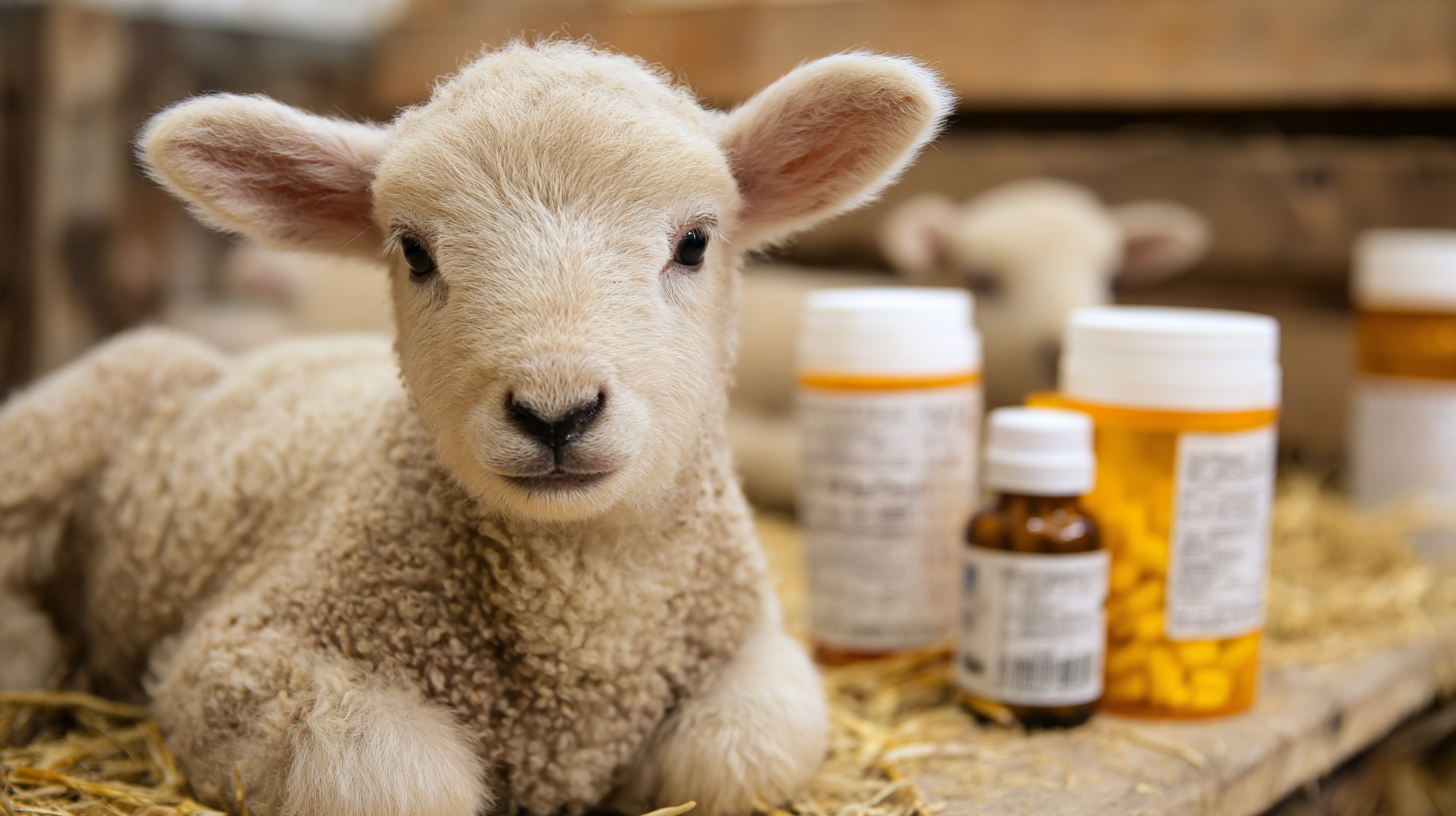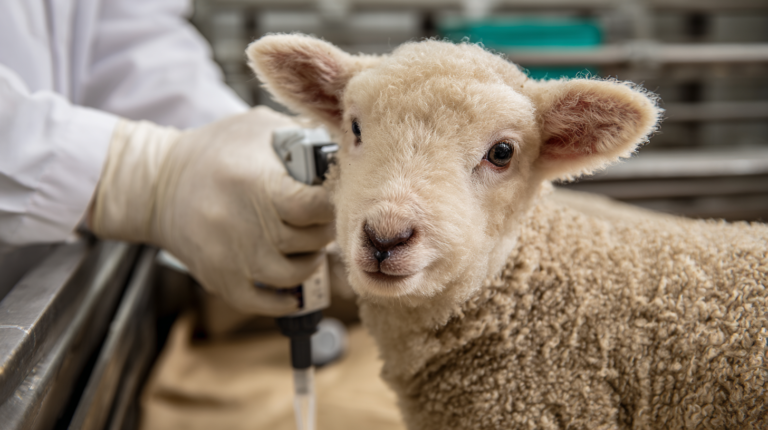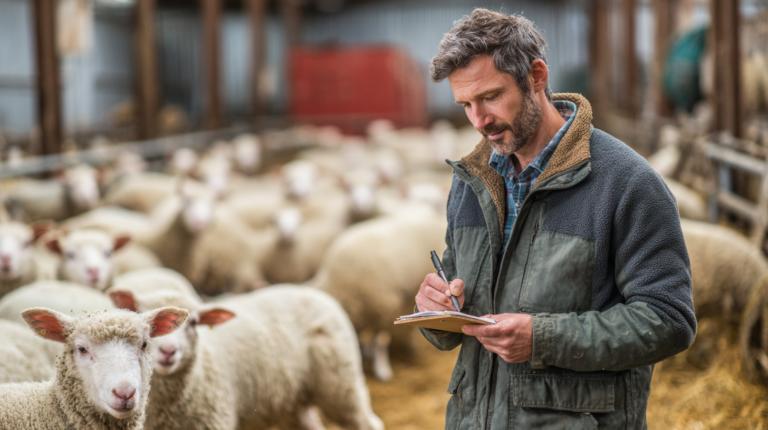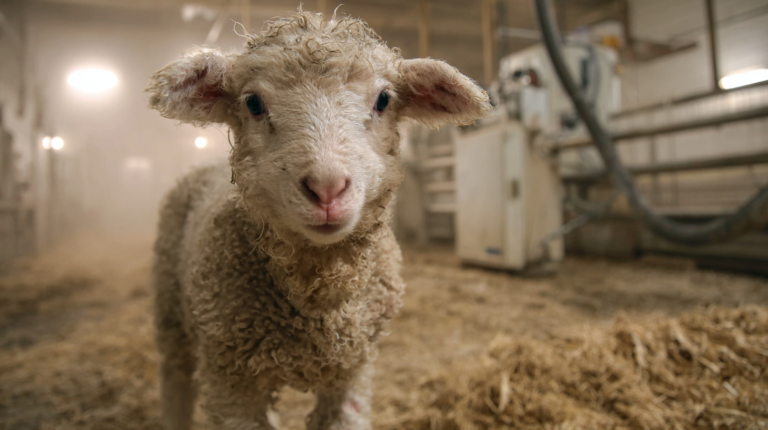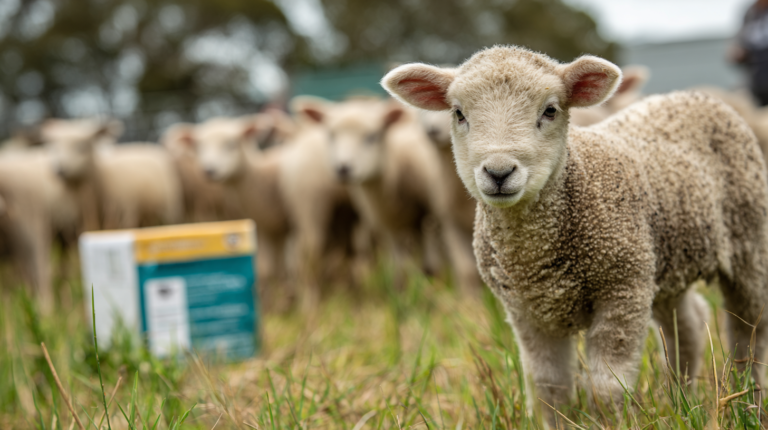Learn to recognize vitamin toxicity in lambs with 4 critical warning signs. Expert veterinary guidance on prevention, symptoms, and treatment for healthy sheep management.
Table of Contents
Vitamin toxicity in lambs represents one of the most overlooked yet potentially fatal conditions affecting young sheep worldwide. While vitamins are essential for proper growth and development, excessive supplementation can transform these beneficial nutrients into dangerous toxins that threaten your flock’s health and productivity.
As sheep farming continues to evolve with modern husbandry practices, well-meaning farmers and shepherds often fall into the trap of “more is better” when it comes to vitamin supplementation. However, this approach can lead to devastating consequences for lambs, whose developing systems are particularly vulnerable to vitamin overdoses.
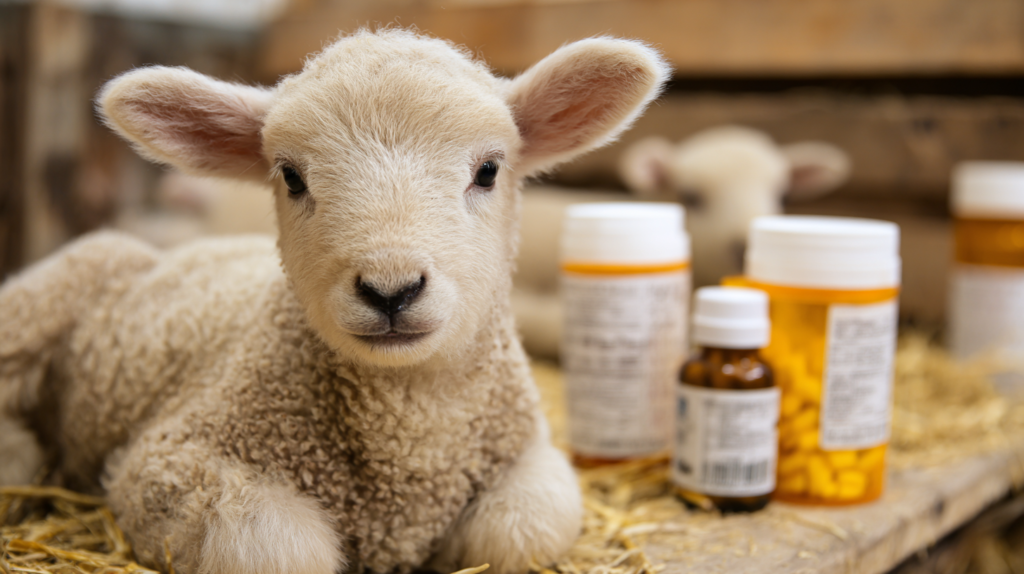
Understanding the delicate balance between adequate nutrition and dangerous excess is crucial for anyone raising sheep, whether you’re managing a commercial operation or caring for a small hobby flock. The signs of vitamin toxicity in lambs can be subtle at first, making early detection challenging but absolutely critical for successful intervention.
Recent veterinary studies indicate that vitamin toxicity cases in young ruminants have increased by 23% over the past decade, largely due to improper supplementation practices and misunderstanding of nutritional requirements. This alarming trend underscores the importance of education and awareness among sheep caretakers.
| Vitamin Type | Solubility | Toxicity Risk Level | Time to Symptoms | Storage in Body |
|---|---|---|---|---|
| Vitamin A | Fat-soluble | High | Days to weeks | Liver tissue |
| Vitamin D | Fat-soluble | High | Days to weeks | Adipose tissue |
| Vitamin E | Fat-soluble | Medium | Weeks to months | Cell membranes |
| Vitamin K | Fat-soluble | Medium | Days to weeks | Liver tissue |
| Vitamin C | Water-soluble | Low | Hours to days | Minimal storage |
| B-Complex Vitamins | Water-soluble | Low | Hours to days | Minimal storage |
| Vitamin B12 | Water-soluble | Medium | Days to weeks | Liver tissue |
Understanding Vitamin Toxicity in Lambs
Vitamin toxicity, also known as hypervitaminosis, occurs when lambs consume excessive amounts of vitamins that accumulate in their tissues to harmful levels. Unlike water-soluble vitamins that are readily excreted through urine, fat-soluble vitamins (A, D, E, and K) can build up in fatty tissues and the liver, creating dangerous concentrations that disrupt normal physiological functions.
Lambs are particularly susceptible to vitamin toxicity due to their rapid growth rates, immature liver function, and smaller body size compared to adult sheep. Their developing digestive systems may not efficiently process excessive vitamin loads, leading to accumulation and subsequent toxicity symptoms.
The most common causes of vitamin toxicity in lambs include overzealous supplementation by caretakers, accidental overdosing during feed mixing, contaminated feed sources, and the cumulative effect of multiple vitamin-fortified products. Many commercial lamb feeds already contain adequate vitamin levels, making additional supplementation unnecessary and potentially harmful.
Dr. Sarah Mitchell, a veterinary nutritionist at Colorado State University, explains: “Lamb owners often believe they’re providing optimal care by adding extra vitamins, but this well-intentioned practice can actually compromise their animals’ health. The key is understanding that lambs have specific nutritional requirements that don’t always align with ‘more is better’ thinking.”
Environmental factors also play a role in vitamin toxicity development. Lambs grazing on vitamin-rich pastures while receiving supplemental vitamins face increased risk of overdose. Additionally, stress conditions such as weaning, transportation, or illness can alter vitamin metabolism, making toxicity more likely even with previously safe supplementation levels.
The 4 Critical Warning Signs of Vitamin Toxicity in Lambs
1. Neurological Abnormalities and Behavioral Changes
The first and often most noticeable sign of vitamin toxicity in lambs manifests through neurological symptoms and dramatic behavioral changes. Affected lambs may exhibit confusion, disorientation, and loss of coordination that progresses rapidly if left untreated.
Vitamin A toxicity particularly affects the nervous system, causing lambs to display unusual head tilting, circling behavior, and difficulty maintaining balance. These symptoms can be mistaken for other neurological conditions, making accurate diagnosis challenging for inexperienced caretakers.
Affected lambs often show increased sensitivity to light and sound, becoming agitated or fearful in situations they would normally handle calmly. This hypersensitivity can manifest as excessive bleating, attempting to hide in dark corners, or aggressive behavior toward other flock members.
Seizure activity represents the most severe neurological manifestation of vitamin toxicity. These episodes may begin as mild muscle tremors but can progress to full convulsions if the toxic load continues to increase. Immediate veterinary intervention is essential when seizures occur, as they indicate severe systemic toxicity.
Sleep pattern disruptions are another early warning sign that’s often overlooked. Affected lambs may appear restless, unable to settle into normal rest periods, or conversely, may seem excessively lethargic and unresponsive to normal stimuli. These changes in sleep behavior often precede more severe neurological symptoms.
2. Gastrointestinal Distress and Digestive Complications
Vitamin toxicity in lambs frequently presents with severe gastrointestinal symptoms that can rapidly lead to dehydration and nutritional deficiencies. The digestive system bears the brunt of excessive vitamin intake, particularly with fat-soluble vitamins that require extensive processing by the liver and intestines.
Diarrhea is typically the first gastrointestinal sign, often accompanied by unusual stool coloration ranging from bright yellow to dark, tarry consistency. The severity and persistence of diarrhea can quickly lead to electrolyte imbalances and dehydration, particularly dangerous in young lambs with limited body reserves.
Vomiting, while less common in sheep than other animals, can occur in severe cases of vitamin toxicity. When present, it often indicates significant liver involvement and requires immediate veterinary attention. The vomited material may contain blood or bile, suggesting serious internal complications.
Loss of appetite represents another critical warning sign that’s often the first symptom observant caretakers notice. Affected lambs may show initial interest in food but quickly lose enthusiasm, leading to reduced feed intake and subsequent weight loss. This appetite suppression can create a dangerous cycle where the lamb becomes more susceptible to other health complications.
Abdominal pain and discomfort manifest through unusual positioning, such as standing with an arched back, reluctance to move, or frequent lying down and standing up. Lambs may also exhibit grinding teeth (bruxism) or excessive salivation, indicating significant digestive distress.
3. Respiratory and Cardiovascular Symptoms
The respiratory and cardiovascular systems of lambs are particularly vulnerable to vitamin toxicity, with symptoms that can rapidly progress to life-threatening complications. These signs often develop more gradually than neurological symptoms but can be equally dangerous if left untreated.
Labored breathing or dyspnea is frequently observed in lambs experiencing vitamin toxicity, particularly with vitamin D overdose. The breathing pattern may appear shallow and rapid, or conversely, deep and labored as the lamb struggles to maintain adequate oxygen levels. This respiratory distress can worsen rapidly, especially during periods of physical activity or stress.
Heart rate abnormalities, including both tachycardia (rapid heart rate) and bradycardia (slow heart rate), can occur depending on the specific vitamin involved and the severity of toxicity. These cardiac irregularities may be detected through physical examination by experienced handlers who notice changes in the lamb’s pulse strength or rhythm.
Fluid accumulation in the lungs, known as pulmonary edema, represents a serious complication of vitamin toxicity that can be fatal if not addressed promptly. Signs include frothy discharge from the nose, open-mouth breathing, and a characteristic “wet” sound during respiration.
Coughing fits that persist beyond normal respiratory infections may indicate vitamin toxicity, particularly when accompanied by other symptoms. These coughing episodes often worsen when the lamb is moved or stressed, suggesting underlying respiratory compromise.
Exercise intolerance becomes apparent when previously active lambs show reluctance to move, rapid fatigue during normal activities, or an inability to keep up with flock mates. This symptom often develops gradually and may be initially attributed to other causes before the connection to vitamin toxicity is established.
4. Skin and Coat Abnormalities
The integumentary system, including skin and wool, provides valuable visual indicators of vitamin toxicity in lambs. These changes are often among the first signs observant caretakers notice, making them crucial for early detection and intervention.
Dry, flaky skin conditions that develop rapidly and don’t respond to typical moisturizing treatments may indicate vitamin A toxicity. The skin may appear thickened and lose its normal elasticity, with areas of scaling or peeling that seem to worsen despite treatment attempts.
Wool quality deterioration becomes apparent through changes in texture, color, and growth patterns. Affected lambs may develop brittle, easily broken wool that lacks the normal luster and softness associated with healthy fleece. In severe cases, wool loss or alopecia may occur in patchy patterns across the body.
Skin lesions and sores that appear without obvious external causes can indicate vitamin toxicity, particularly when they fail to heal at normal rates. These lesions may be accompanied by secondary bacterial infections that complicate the overall clinical picture.
Unusual pigmentation changes, including areas of hyperpigmentation (darkening) or hypopigmentation (lightening), may develop in response to vitamin toxicity. These changes are often permanent and serve as lasting reminders of the toxic episode.
Swelling or edema in the skin, particularly around the face, legs, and udder area in female lambs, can indicate severe vitamin toxicity with cardiovascular complications. This swelling may be accompanied by heat and tenderness, suggesting inflammatory processes.
| Sign # | Category | Specific Symptoms | Severity Level | Action Required |
|---|---|---|---|---|
|
1
|
Neurological Abnormalities
|
• Disorientation and confusion
• Seizures or tremors • Loss of coordination • Altered mental state • Weakness or paralysis |
Critical | Immediate veterinary care |
|
2
|
Gastrointestinal Distress
|
• Severe diarrhea
• Vomiting or regurgitation • Loss of appetite • Abdominal pain • Dehydration |
High | Urgent veterinary attention |
|
3
|
Respiratory & Cardiovascular
|
• Labored breathing
• Rapid heart rate • Irregular pulse • Cyanosis (blue coloring) • Exercise intolerance |
Critical | Emergency intervention |
|
4
|
Skin & Coat Abnormalities
|
• Hair loss or poor coat quality
• Skin lesions or dermatitis • Excessive scaling • Color changes in skin • Delayed wound healing |
Moderate | Veterinary consultation |
Prevention Strategies for Vitamin Toxicity
Preventing vitamin toxicity in lambs requires a comprehensive approach that combines proper nutritional management, careful supplementation practices, and regular monitoring of flock health. The foundation of prevention lies in understanding that lambs have specific nutritional requirements that differ significantly from adult sheep and other livestock species.
Feed analysis represents the first critical step in prevention. Regular testing of pasture grass, hay, and commercial feeds provides essential information about existing vitamin levels, allowing caretakers to make informed decisions about supplementation needs. Many commercial lamb feeds already contain adequate vitamin levels, making additional supplementation unnecessary and potentially harmful.
Proper storage of vitamin supplements is crucial for maintaining their potency and preventing accidental overdoses. Supplements should be stored in cool, dry conditions away from direct sunlight and heat sources. Expired supplements can develop concentrated vitamin levels that increase toxicity risk and should be disposed of properly.
Calculating appropriate dosage based on individual lamb weight and age ensures safe supplementation practices. Using kitchen scales or other imprecise measuring tools can lead to dangerous overdoses, particularly with fat-soluble vitamins that accumulate in body tissues.
Environmental considerations play a significant role in prevention strategies. Lambs grazing on lush, vitamin-rich pastures may not require additional supplementation, while those on poor-quality forage may need carefully calculated vitamin support. Seasonal variations in pasture quality must be considered when developing supplementation protocols.
Treatment Approaches and Veterinary Care
When vitamin toxicity in lambs is suspected, immediate veterinary consultation is essential for proper diagnosis and treatment. The complexity of vitamin toxicity requires professional expertise to differentiate between various toxic syndromes and implement appropriate therapeutic interventions.
Diagnosis typically involves a combination of clinical examination, blood work, and careful review of the lamb’s nutritional history. Veterinarians may perform liver function tests, vitamin level assessments, and other diagnostic procedures to confirm toxicity and determine the specific vitamin involved.
Supportive care forms the backbone of treatment for vitamin toxicity in lambs. This includes fluid therapy to address dehydration, electrolyte replacement to correct imbalances, and nutritional support to maintain the lamb’s strength during recovery. The specific supportive measures depend on the symptoms presented and the severity of toxicity.
Eliminating the source of excessive vitamins is the most critical treatment step. This involves immediately discontinuing all vitamin supplementation, reviewing and potentially changing the lamb’s diet, and ensuring no access to vitamin-rich feed sources that may have contributed to the toxicity.
Symptomatic treatment addresses specific complications as they arise. Neurological symptoms may require anti-seizure medications, while gastrointestinal symptoms might need specific therapies to control diarrhea and support digestive function. Respiratory complications may necessitate oxygen therapy or other respiratory support measures.
Recovery monitoring is essential throughout the treatment process. Veterinarians typically recommend regular follow-up examinations to assess improvement, monitor for complications, and adjust treatment protocols as needed. Blood work may be repeated to track vitamin levels and liver function during recovery.
| Timeline Phase | Time Frame | Diagnostic Actions | Treatment Approach | Expected Outcome |
|---|---|---|---|---|
|
Immediate Response (0-6 hours)
|
0-6 Hours |
• Remove all vitamin supplements
• Contact veterinarian immediately • Document symptoms and onset • Collect feed samples |
• Stabilize vital signs
• Provide supportive care • Begin decontamination • IV fluid therapy if needed |
Good if caught early |
|
Acute Treatment (6-24 hours)
|
6-24 Hours |
• Blood chemistry panel
• Liver function tests • Neurological examination • Vitamin level analysis |
• Activated charcoal administration
• Anti-seizure medications • Liver protectants • Monitoring and support |
Variable depending on severity |
|
Short-term Recovery (1-7 days)
|
1-7 Days |
• Daily monitoring of vitals
• Follow-up blood work • Neurological assessments • Nutritional evaluation |
• Continued supportive care
• Dietary modifications • Medication adjustments • Gradual activity increase |
Most recover if treated promptly |
|
Long-term Management (1-4 weeks)
|
1-4 Weeks |
• Weekly health assessments
• Growth rate monitoring • Organ function evaluation • Behavioral observations |
• Nutritional rehabilitation
• Vitamin supplement adjustment • Environmental modifications • Prevention protocol implementation |
Full recovery expected |
|
Prevention & Monitoring (Ongoing)
|
Lifelong |
• Regular health check-ups
• Annual blood screening • Feed analysis reviews • Growth pattern tracking |
• Balanced nutrition program
• Controlled supplementation • Owner education • Early warning system |
Prevention of recurrence |
Long-term Management and Monitoring
Successful management of lambs recovering from vitamin toxicity requires ongoing vigilance and systematic monitoring approaches. The recovery process can be lengthy, and some effects of vitamin toxicity may persist long after the initial acute phase has resolved.
Developing a comprehensive monitoring schedule helps track recovery progress and identify potential complications early. This includes regular weight checks, behavioral assessments, and periodic veterinary examinations to ensure the lamb is progressing normally.
Nutritional rehabilitation must be carefully managed to avoid triggering another toxic episode while ensuring adequate nutrition for continued growth and development. This often involves working with veterinary nutritionists to develop appropriate feeding programs that meet the lamb’s needs without risking vitamin excess.
Record keeping becomes crucial for long-term management success. Detailed records of symptoms, treatments, recovery progress, and nutritional changes provide valuable information for managing future cases and preventing recurrence in the flock.
Flock-wide assessment may be necessary if one lamb develops vitamin toxicity, as other flock members may have been exposed to the same nutritional conditions. This preventive approach can help identify at-risk individuals before they develop clinical signs.
Educational Resources and Professional Support
Access to reliable educational resources and professional support networks is essential for sheep caretakers seeking to prevent and manage vitamin toxicity in lambs. Understanding where to find accurate information and when to seek professional help can make the difference between successful treatment and tragic outcomes.
Veterinary nutritionists represent the gold standard for professional guidance on lamb nutrition and vitamin supplementation. These specialists can provide customized feeding programs, evaluate existing nutritional protocols, and offer ongoing support for complex cases.
Extension services through agricultural universities offer valuable educational programs and resources for sheep producers. These programs often include workshops on lamb nutrition, feeding management, and recognizing common health problems including vitamin toxicity.
Professional sheep organizations provide networking opportunities with experienced producers who have dealt with similar challenges. These connections can offer practical advice and emotional support during difficult treatment periods.
Frequently Asked Questions
Everything you need to know about vitamin toxicity in lambs
How quickly can vitamin toxicity develop in lambs?
Vitamin toxicity in lambs can develop within hours to days of excessive intake, depending on the specific vitamin involved and the amount consumed. Fat-soluble vitamins (A, D, E, K) tend to accumulate more slowly but can cause severe toxicity, while water-soluble vitamin overdoses may show symptoms more rapidly but are generally less dangerous.
Can vitamin toxicity in lambs be reversed completely?
The reversibility of vitamin toxicity depends on the specific vitamin involved, the severity of toxicity, and how quickly treatment is initiated. While many cases can be successfully treated with full recovery, some severe cases may result in permanent damage, particularly neurological or liver complications.
Are certain breeds of lambs more susceptible to vitamin toxicity?
While all lamb breeds can develop vitamin toxicity, smaller breeds and those with rapid growth rates may be at higher risk due to their metabolic demands and body size. Additionally, lambs with pre-existing health conditions or compromised liver function may be more susceptible to vitamin toxicity.
How can I tell if my commercial lamb feed contains adequate vitamins?
Commercial lamb feeds are required to list vitamin content on their labels. Look for feeds that meet or exceed National Research Council (NRC) requirements for lamb nutrition. If you’re unsure, consult with a veterinary nutritionist who can analyze your feeding program and recommend appropriate supplementation levels.
What should I do if I suspect my lamb has vitamin toxicity?
If you suspect vitamin toxicity, immediately remove all vitamin supplements from the lamb’s diet and contact your veterinarian. Provide your veterinarian with detailed information about the lamb’s diet, any supplements given, and the onset of symptoms. Early intervention significantly improves the chances of successful treatment.
Can vitamin toxicity affect adult sheep the same way it affects lambs?
Adult sheep can develop vitamin toxicity, but they are generally less susceptible than lambs due to their mature liver function and larger body size. However, pregnant ewes may be at increased risk due to altered metabolism and the demands of pregnancy.
No questions found matching your search. Try different keywords or browse all questions above.
For more expert pet care tips and product recommendations, visit BlithePet.com — your trusted source for pet wellness.
Conclusion
Vitamin toxicity in lambs represents a serious but preventable condition that requires careful attention to nutritional management and early recognition of warning signs. The four critical symptoms—neurological abnormalities, gastrointestinal distress, respiratory and cardiovascular complications, and skin abnormalities—serve as important indicators that can help caretakers identify problems before they become life-threatening.
Prevention remains the most effective strategy for protecting lambs from vitamin toxicity. This includes understanding proper supplementation practices, regular feed analysis, appropriate storage of supplements, and working with veterinary professionals to develop comprehensive nutritional programs tailored to specific flock needs.
When toxicity does occur, rapid intervention and professional veterinary care offer the best chances for successful recovery. The complexity of vitamin toxicity requires expertise to navigate the diagnostic process, implement appropriate treatments, and monitor recovery progress effectively.
The increasing incidence of vitamin toxicity cases in young ruminants highlights the importance of education and awareness among sheep caretakers. By understanding the risks, recognizing the warning signs, and implementing preventive strategies, we can protect our flocks while ensuring optimal nutrition for healthy growth and development.
Remember that the goal of lamb nutrition is not maximizing vitamin intake but rather providing balanced nutrition that supports healthy growth without risking toxic accumulation. Working with veterinary professionals and staying informed about best practices in sheep nutrition will help ensure the health and productivity of your flock for years to come.
Have a similar experience with your pet? Share it in the comments below!

